-
Sign up or login, and you'll have full access to opportunities of forum.
You are using an out of date browser. It may not display this or other websites correctly.
You should upgrade or use an alternative browser.
You should upgrade or use an alternative browser.
Roman Resources
- Thread starter RacingRodent
- Start date

Praefectus Praetorio
R.I.P. Brother of the Quill
One thing PrPr's video gets wrong - and nearly all depictions of the ancient world get wrong - is all those white statues.
This video explains what they may have looked like and why we got things wrong.
Both posts are valid. One thing we have certainly learned in the last 100 years is that the Greco-Roman world wasn't all white marble. They painted almost everything.I hate how the art historians find traces of paint, and jump right to elementary school colors instead of more muted and realistic colors matching the realistic forms of the statues.
Naraku
Draconarius
The ancients only had a limit number of colors available using ground minerals and plants.I hate how the art historians find traces of paint, and jump right to elementary school colors instead of more muted and realistic colors matching the realistic forms of the statues.
Also, many of these were meant to be seen from a distance. The friezes along the top of the Parthenon - most of which are now in the British Museum) would haven been 45 feet (13.72m) above the observers, so subtle coloring wouldn't have been visible.

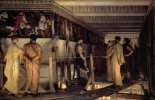
(The second image is by Lawrence Alma Tadema, who knew in 1868 that the frieze was painted.)
Anyway, I think some of them look pretty good.

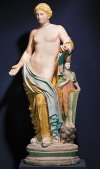
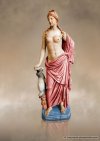
Marcius
Tribune
Statistical reliability analysis for a most dangerous occupation: Roman emperor
Uneasy lay the heads.
Uneasy lay the heads.
Frank Petrexa
Tribune
Praefectus Praetorio
R.I.P. Brother of the Quill
Roman Fast Food
malins
Stumbling Seeker
Not Roman, but just using this as "historical resources" ...
Egyptian beadnet dresses, ca 2500 BC
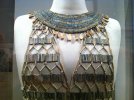
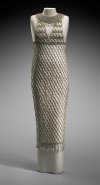
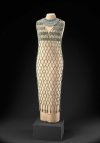
How were they worn ... it's assumed that often they were worn over fabric, making it conform more closely to the body.
However there is also this:
So was that just plain nets or his kind of dress? (one would have to be an egyptologist)
For the last one:
On reconstruction,
Depictions of women in Egyptian art occasionally feature garments decorated with an overall lozenge pattern. This design is believed to represent beadwork, which was either sewn onto a linen dress or worked into a separate net worn over the linen. This beadnet dress is the earliest surviving example of such a garment. It has been painstakingly reassembled from approximately seven thousand beads found in an undisturbed burial of a female contemporary of King Khufu. Although their string had disintegrated, a few beads still lay in their original pattern on and around the mummy, permitting an accurate reconstruction. The color of the beads has faded, but the beadnet was originally blue and blue green in imitation of lapis lazuli and turquoise.
A possible depiction
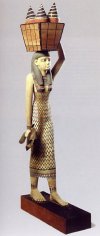
Egyptian beadnet dresses, ca 2500 BC



How were they worn ... it's assumed that often they were worn over fabric, making it conform more closely to the body.
However there is also this:
King Sneferu ... on a sailing trip on the palace lake, recorded on a papyrus dating from around 1800 BC.:
The King gets twenty young women to row a boat and, to relieve his boredom, orders:
‘Let there be brought to me twenty women with the shapeliest bodies, breasts and braids, who have not yet given birth.
And let there be brought to me 20 nets. Give those nets to these women in place of their clothes!'”
The King gets twenty young women to row a boat and, to relieve his boredom, orders:
‘Let there be brought to me twenty women with the shapeliest bodies, breasts and braids, who have not yet given birth.
And let there be brought to me 20 nets. Give those nets to these women in place of their clothes!'”
So was that just plain nets or his kind of dress? (one would have to be an egyptologist)
For the last one:
“Each of the 127 shells around the fringe are plugged with a small stone so that it would have emitted a rattling sound when the wearer moved.”
On reconstruction,
Depictions of women in Egyptian art occasionally feature garments decorated with an overall lozenge pattern. This design is believed to represent beadwork, which was either sewn onto a linen dress or worked into a separate net worn over the linen. This beadnet dress is the earliest surviving example of such a garment. It has been painstakingly reassembled from approximately seven thousand beads found in an undisturbed burial of a female contemporary of King Khufu. Although their string had disintegrated, a few beads still lay in their original pattern on and around the mummy, permitting an accurate reconstruction. The color of the beads has faded, but the beadnet was originally blue and blue green in imitation of lapis lazuli and turquoise.
A possible depiction

Rias
Neko Girl
oho its squirrel favourite food crunchy outside yummy gummy inside what else expresso also w8 must bring some slugs for squirrel from garden meowRoman Fast Food


Naraku
Draconarius
The Ancient Egyptians certainly weren't shy.Not Roman, but just using this as "historical resources" ...
Egyptian beadnet dresses, ca 2500 BC
View attachment 955882
View attachment 955883View attachment 955884
How were they worn ... it's assumed that often they were worn over fabric, making it conform more closely to the body.
However there is also this:
King Sneferu ... on a sailing trip on the palace lake, recorded on a papyrus dating from around 1800 BC.:The King gets twenty young women to row a boat and, to relieve his boredom, orders:‘Let there be brought to me twenty women with the shapeliest bodies, breasts and braids, who have not yet given birth.And let there be brought to me 20 nets. Give those nets to these women in place of their clothes!'”
So was that just plain nets or his kind of dress? (one would have to be an egyptologist)
For the last one:
“Each of the 127 shells around the fringe are plugged with a small stone so that it would have emitted a rattling sound when the wearer moved.”
On reconstruction,
Depictions of women in Egyptian art occasionally feature garments decorated with an overall lozenge pattern. This design is believed to represent beadwork, which was either sewn onto a linen dress or worked into a separate net worn over the linen. This beadnet dress is the earliest surviving example of such a garment. It has been painstakingly reassembled from approximately seven thousand beads found in an undisturbed burial of a female contemporary of King Khufu. Although their string had disintegrated, a few beads still lay in their original pattern on and around the mummy, permitting an accurate reconstruction. The color of the beads has faded, but the beadnet was originally blue and blue green in imitation of lapis lazuli and turquoise.
A possible depiction
View attachment 955885
Servants and performers were often nude or semi-nude.



But, all women seem to have gone topless or in almost see-through dresses.
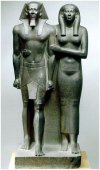


Even nobles.
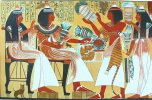
old slave
FELIS RESPICIENS
I remember a BBC TV historical costume drama about ancient Egypt about 30 years ago, and the servant class girls were all topless. It was very daring for the time.The Ancient Egyptians certainly weren't shy.
Servants and performers were often nude or semi-nude.
View attachment 956765View attachment 956771View attachment 956769
But, all women seem to have gone topless or in almost see-through dresses.
View attachment 956766View attachment 956767View attachment 956770
Even nobles.
View attachment 956768
Migoz2
Senator
Damn! I would have liked to have seen that. Eroticism and opera go well together in my book!Some years back, I posted a YouTube link of a performance of the priestesses' dance in Verdi's Aida with some of the performers tastefully topless, but sadly YouTube's censored it. Boob-tubes are compulsory on YouTube
Frank Petrexa
Tribune
Give them a break. It's hot down there. Maybe it wasn't all libertine lust. People had to work. (In the last chapter of John, after the Resurrection, "the Lord" appears on the shore and tells the apostles where to cast the net after they had worked all night and caught nothing. When the "beloved disciple" says, "it is the Lord", Peter puts on his robe (incongruously) and dives in to swim ashore, leaving the others to haul in the fish, since he was "stripped for work". So, apparently context matters.) I don't imagine a lot of ancient Egyptians got to bathe all that much, since the Nile was it as far as water is concerned.The Ancient Egyptians certainly weren't shy.
Servants and performers were often nude or semi-nude.
View attachment 956765View attachment 956771View attachment 956769
But, all women seem to have gone topless or in almost see-through dresses.
View attachment 956766View attachment 956767View attachment 956770
Even nobles.
View attachment 956768
Frank Petrexa
Tribune
Yes, perfumes are definitely preferable to taking your chances with crocodiles. There were lots of those.They - at least the ruling class - were keen on cosmetics, perfumes, aromatic oils. But then they probably needed them, and well-trained slavegirls to apply them.
Praefectus Praetorio
R.I.P. Brother of the Quill
Channeling your ancestors, girl? Longing for the "flesh-pots" of Egypt? (Of course, flesh-pots meant stewing meat, not carnal indulgence.)They - at least the ruling class - were keen on cosmetics, perfumes, aromatic oils. But then they probably needed them, and well-trained slavegirls to apply them.
Praefectus Praetorio
R.I.P. Brother of the Quill
If you were my slave in ancient Egypt. You would be lucky and you would get more than leftovers from me (and not just food!)I think stewing meat is more of a carnal indulgence than applying aromatic unguents to a royal lady's skin. But she's the one who gets to indulge, in whatever way she pleases. If I'm lucky, I get the leftovers, ditto.


